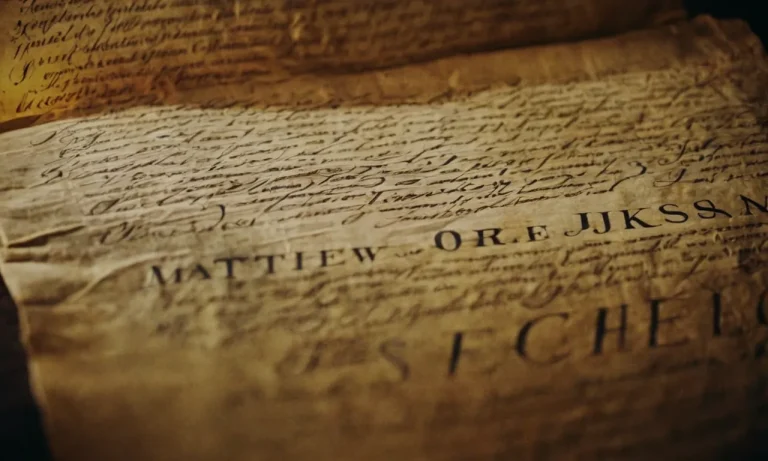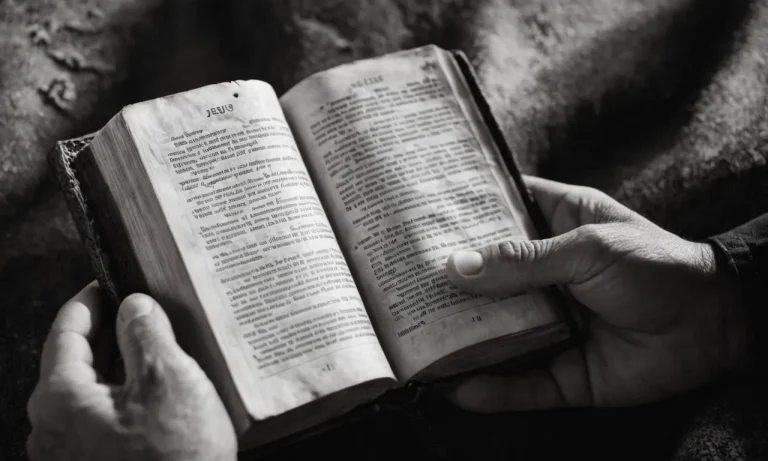What Does The Bible Say About The Veil Being Lifted?
The concept of the veil in the Bible is rich with meaning about our relationship with God. At times, it represents how sin can separate us from fully knowing God. The good news is that Christ’s death on the cross tore open the curtain to God’s presence, giving us direct access to Him by grace through faith.
If you’re short on time, here’s a quick answer: The Bible speaks metaphorically about a veil that separates humanity from directly perceiving God’s glory and presence. In Christ, this veil is torn open and believers have intimate fellowship with God by the Spirit.
The Veil in the Old Testament Tabernacle
The Tabernacle Veil as a Separator
The veil in the Old Testament tabernacle served as a separator between the Holy Place and the Most Holy Place (Exodus 26:31-33). It created a boundary between the general priesthood and God’s glorious presence that dwelt over the Ark of the Covenant.
Only the High Priest could enter the Most Holy Place, and only once a year on the Day of Atonement (Leviticus 16:2).
This veil symbolized the separation between God and humanity due to sin (Isaiah 59:2). Except for the High Priest’s annual entrance, the veil denied access to God’s presence. The exclusive access showed how distant and inaccessible God seemed.
However, the tearing of the veil at Christ’s death dramatically illustrated that believers now have direct access to God through Christ’s atoning sacrifice (Hebrews 10:19-20).
The Veil Hiding God’s Glory
The tabernacle veil also hid the brilliant glory of God’s presence from view. God’s Shekinah glory descended and filled the Most Holy Place when the tabernacle was complete (Exodus 40:34-35). However, the dense veil kept this glory cloud unseen behind the veil except by the High Priest when he entered the Most Holy Place.
The concealed glory emphasized God’s holiness, humanity’s imperfection, and the need for blood atonement to cover sin before approaching that glory. It also built anticipation for the day when Christ would provide access for all believers to behold God’s glory forever (John 17:24).
Just as the veil kept God’s glory out of sight, so did Christ’s humanity veil His divine glory until His resurrection and ascension (Hebrews 10:20).
Imagery of Lifting the Veil in the New Testament
Jesus as the Veil Torn in Two
When Jesus died on the cross, the veil in the temple was torn in two from top to bottom (Matthew 27:51). This signifies that through Christ’s death, the barrier between God and man was removed. People now had direct access to God through Jesus’ sacrifice.
The torn veil symbolizes the opening of heaven and the presence of God being made available to all people, not just the Jewish high priest. Jesus serves as the new high priest who intercedes for us before God (Hebrews 4:14-16).
In addition, just as the veil separated the common people from the presence of God in the Holy of Holies, Christ’s flesh served as a veil that “covered” his deity on earth (Hebrews 10:20). When his flesh was torn at death, Christ’s glory was revealed.
The imagery of Jesus as the veil points to him making God accessible to all and unveiling God’s glory through his crucifixion.
Believers Seeing God’s Glory with Unveiled Faces
Paul writes that when anyone turns to the Lord, “the veil is taken away” (2 Corinthians 3:16). As believers gaze at Christ with unveiled faces, we all reflect “the Lord’s glory” and are transformed into his image (2 Corinthians 3:18).
Lifting the veil speaks of gaining new understanding of Jesus and the gospel message. The Holy Spirit gives us fresh revelation of biblical truths and application to our lives.
Paul contrasts the radiant, unveiled faces of believers with the Israelites after Moses descended from Mount Sinai. After speaking face-to-face with God, Moses wore a veil over his face because the Israelites were afraid to come near him due to the glory radiating from him (Exodus 34:29-35).
We, however, have confidence to approach our Lord, talk openly with him, and encounter his glory up close through Christ.
Paul’s Teaching on the Hardened Minds of Unbelievers
A Veil over Those Who Reject the Gospel
In 2 Corinthians 3:12-18, the apostle Paul teaches that unbelievers have a veil over their minds that prevents them from understanding the truth of the gospel. He contrasts this spiritual blindness with the new freedom that comes from turning to Christ and having the veil removed.
Paul says that when the old covenant is read, a veil covers the hearts of those who do not believe in Jesus (v.15). Their minds are hardened against seeing the glory of God revealed in Christ (v.14). Tragically, although the good news about salvation through Jesus is proclaimed to them, the unbelieving do not see it for what it really is – the light and power of God for salvation (v.14).
This spiritual blindness is a fulfillment of Isaiah’s prophecy that the people’s hearts would be hardened so they cannot understand and turn to God (Isaiah 6:9-10, quoted in v.14). Paul is highlighting how the rejection of Jesus as Messiah by so many of the Jewish people is evidence that a veil remains over their minds.
The God of This Age Blinding Minds
Paul explains that the reason people do not believe the gospel is because “the god of this age has blinded the minds of unbelievers” (2 Corinthians 4:4). Satan has the unbelieving in spiritual darkness, preventing them from seeing “the light of the gospel of the glory of Christ.”
Their blindness to the truth is supernaturally caused by the work of the devil.
We get further insight into how Satan blinds minds from Paul’s warning to the Corinthian church. He warns them about false teachers who preach “another Jesus” and “a different gospel” (2 Cor 11:4). These deceptive teachings are inspired by “such men are false apostles, deceitful workers, disguising themselves as apostles of Christ” (v.13).
Paul says the Satan is behind this deception, “for even Satan disguises himself as an angel of light” (v.14).
Satan’s dark work includes promoting false teachings that prevent people from seeing the truth about Jesus. The unbelieving are trapped in darkness and deceived by the father of lies (John 8:44). Tragically, “the god of this world has blinded the minds of the unbelieving so that they might not see the light of the gospel.”
Conclusion
In Scripture, the veil represents how sin separates us from fully perceiving God. By dying for our sins, Jesus tore open the veil so that through faith in Him, we can come directly into God’s presence and see His glory.
However, those who continue rejecting Christ have a spiritual veil over their minds. As believers, we no longer have obstructed access to knowing God intimately by the Spirit.








